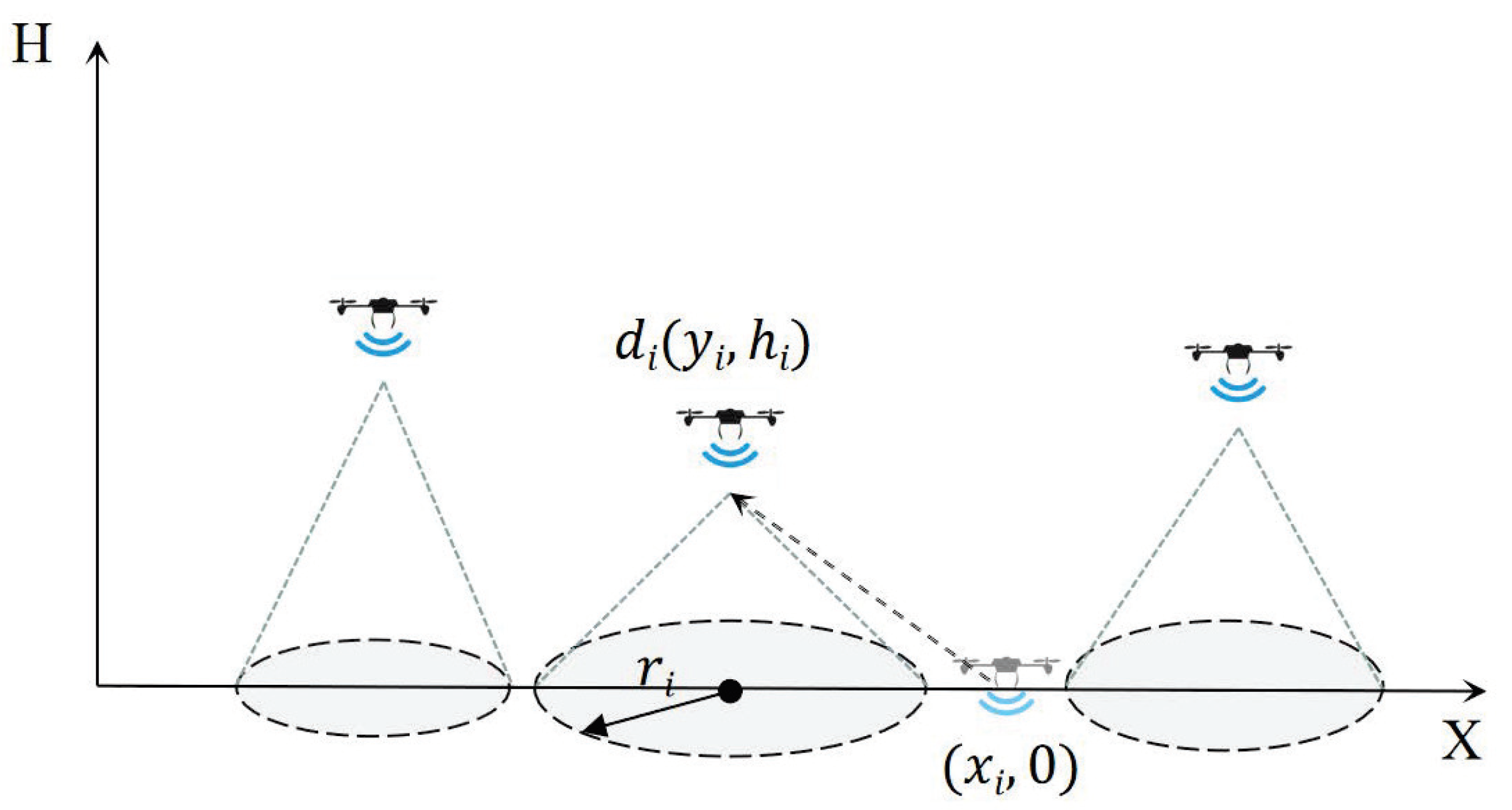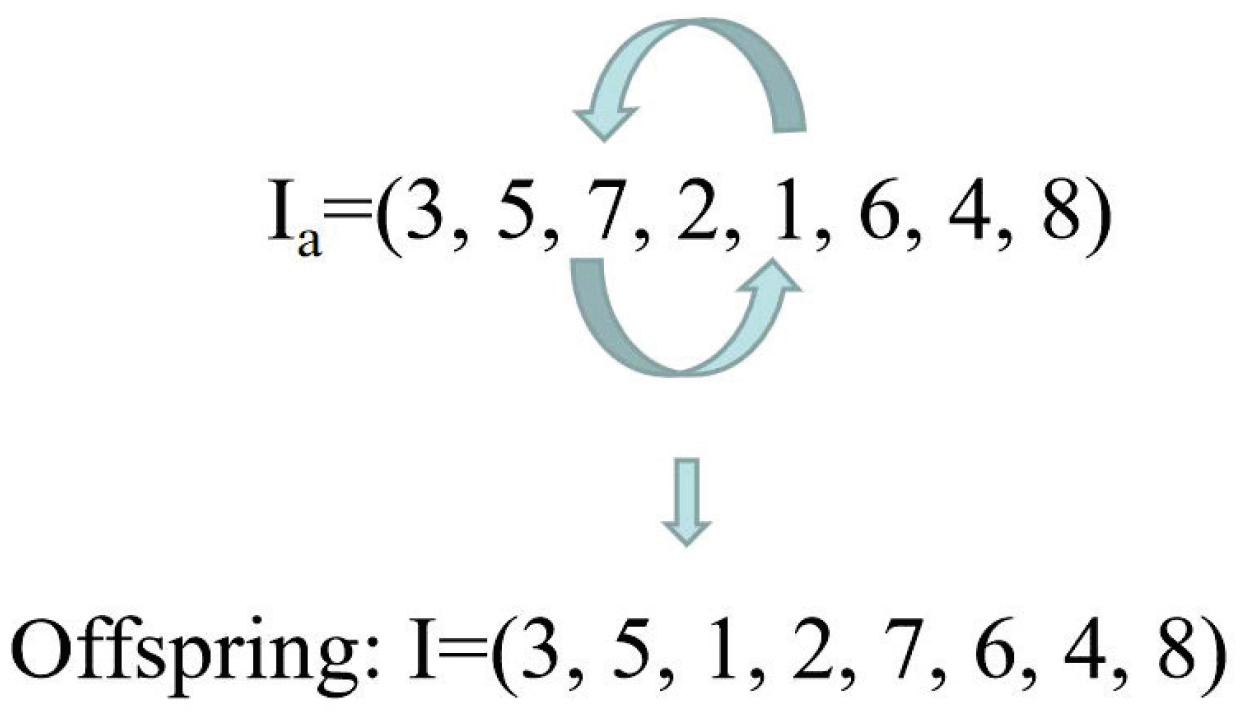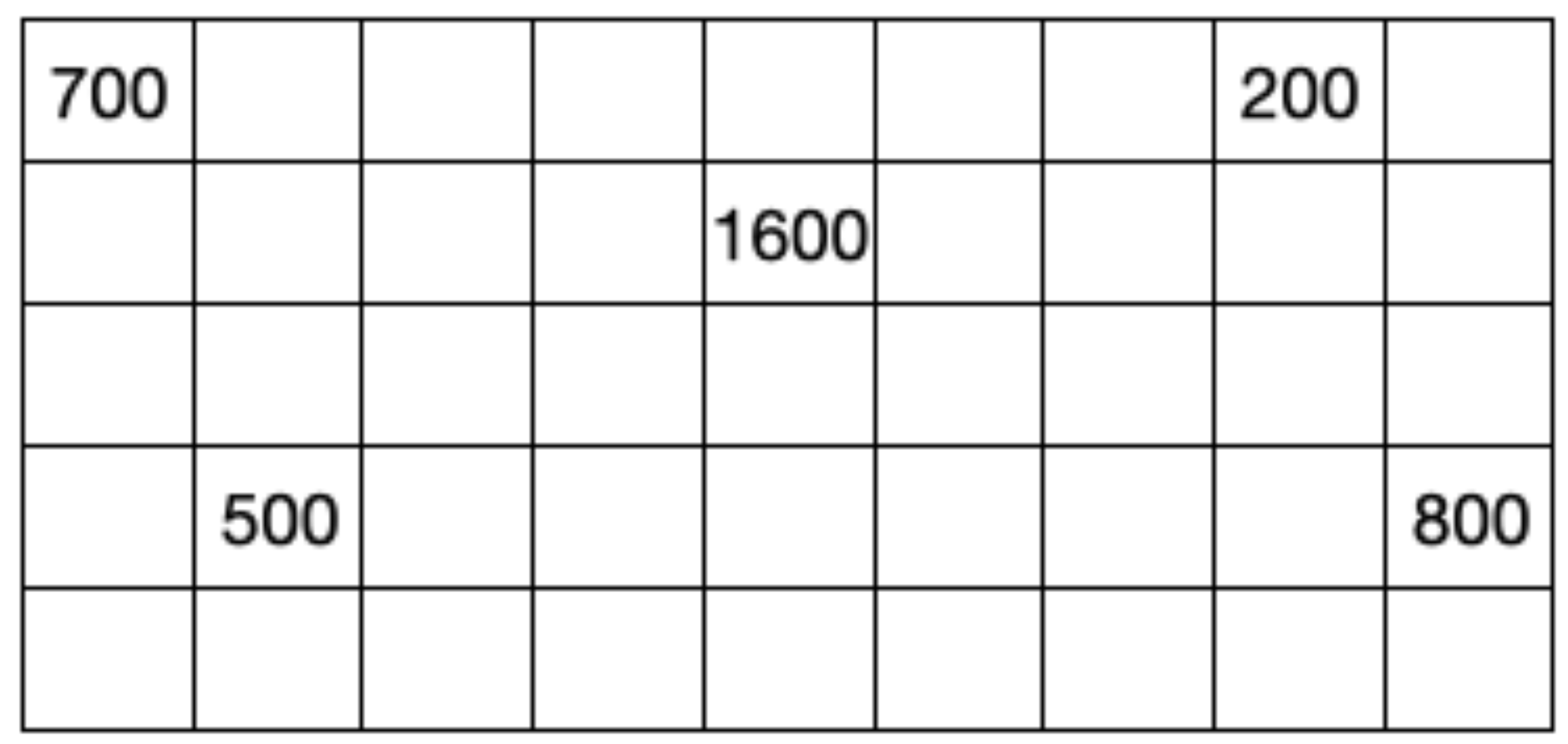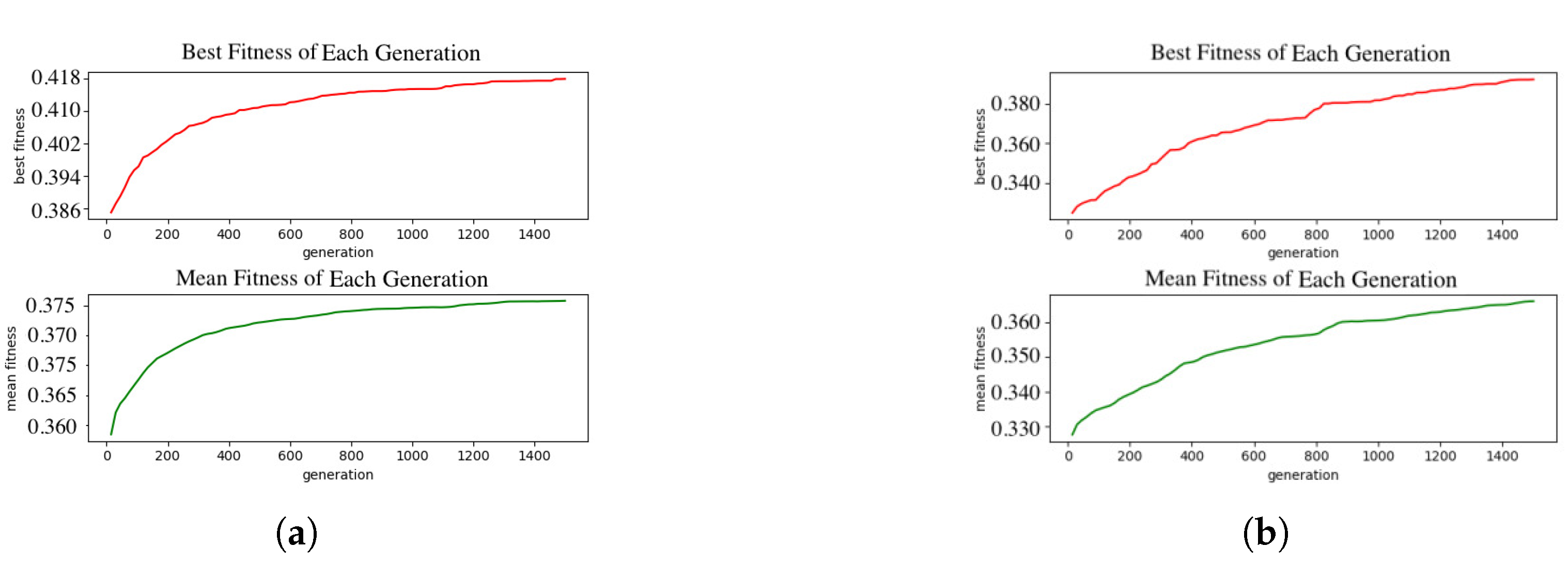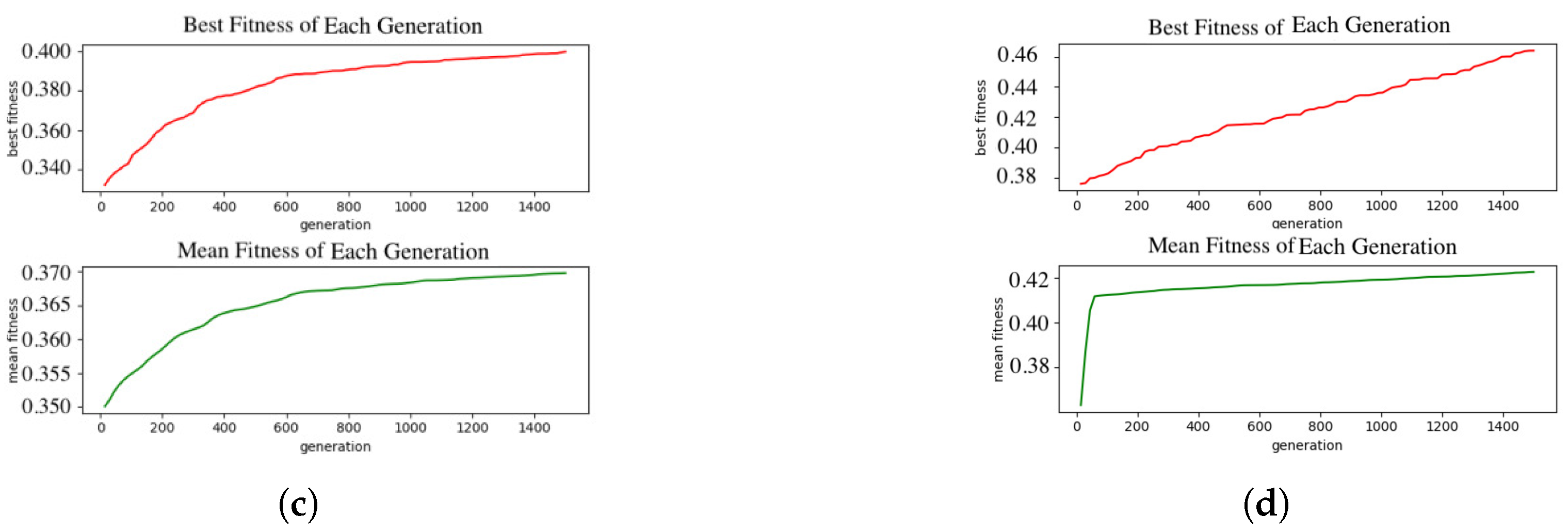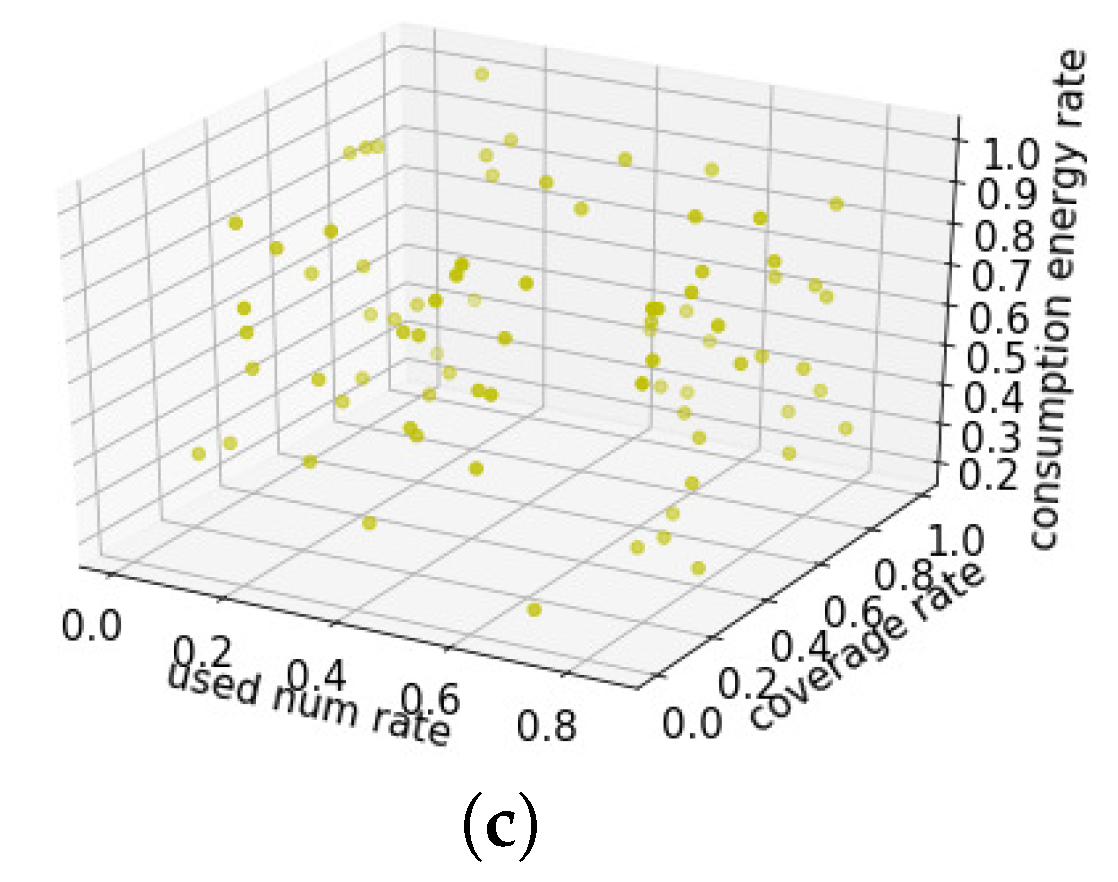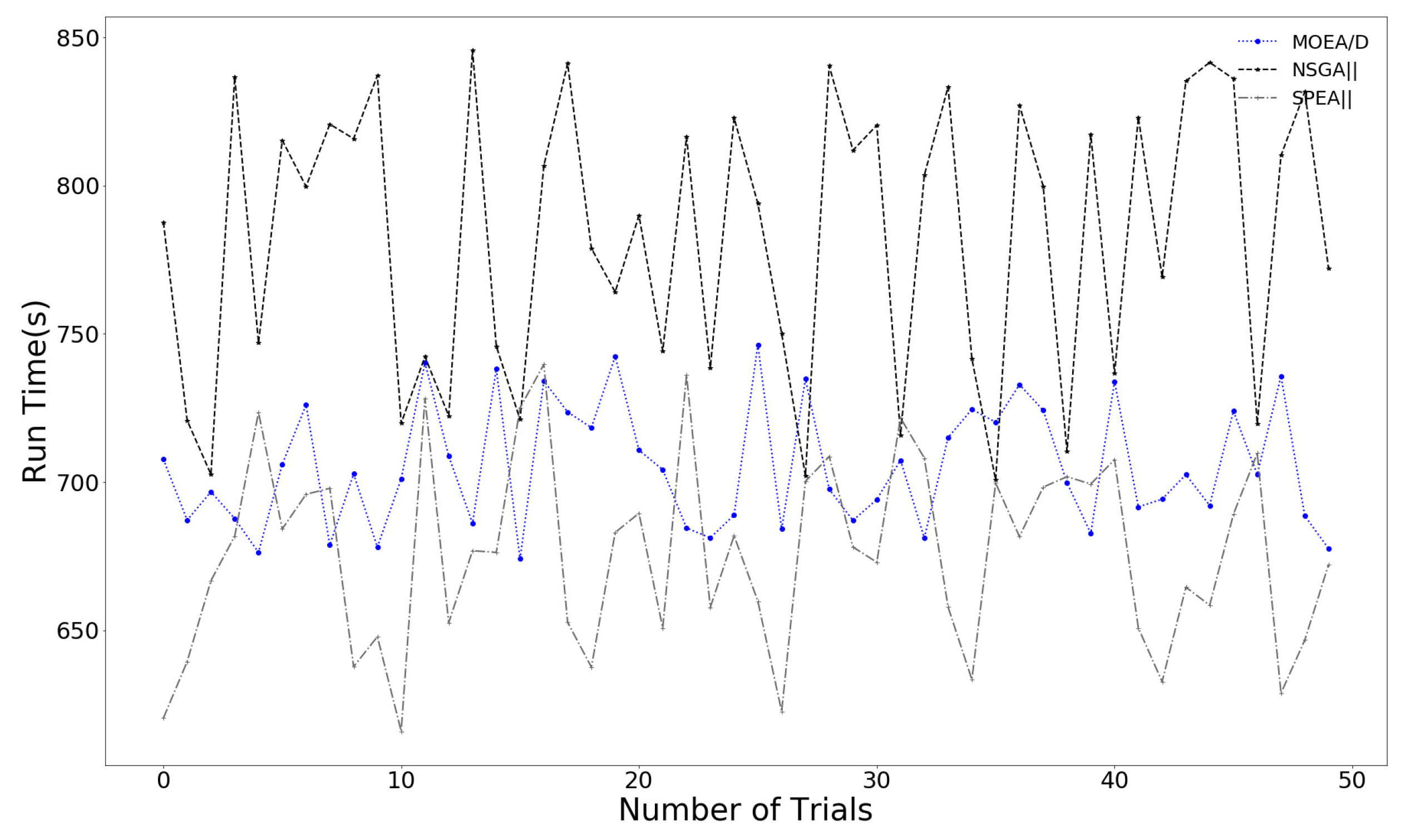1. Introduction
Nowadays, wireless coverage is considered one of the most common drone applications [
1,
2,
3]. Equipped with wireless transceivers, drones can inherently serve as aerial base stations to provide wireless-coverage services for ground users in disconnected areas [
4,
5,
6]. For example, Ref. [
7] employed a drone-aided aerial base station to serve ground users by jointly optimizing the transmit power and the drone’s trajectory to maximize the average throughput per ground user. Ref. [
8] presented two fast drone-swarms deployment schemes for emergencies. Ref. [
9] studied the drone deployment problem to simultaneously optimize the coverage, fault tolerance, and redundancy.
There are some recent studies on the deployment of teams of aerial drones for wireless coverage of ground areas [
10,
11,
12]. Ref. [
10] used the drones and sensors to recognize and track multiple moving targets and [
11] proposed a collision-free three-dimensional deployment algorithm to maximize the overall QoC of targets. Ref. [
12] considered both indoor and outdoor path-loss models and proposed an efficient deployment with a minimum number of UAVs. However, in these works, the energy-consumption issue were largely overlooked.
However, due to the limited wireless-service coverage, a drone needs to consume most of its energy when flying over long distances to the top of a target area, leaving limited energy leftover for the hovering and wireless coverage in the service phase. It is important to minimize the maximum energy consumption before the actual service phase, yet this sustainable-deployment issue has been largely overlooked in the literature, and the target problem is typically NP-hard. The existing literature on drone networks generally assumes the drones have already been deployed over the target area to serve the ground users, and overlook the energy-consumption issue during the deployment of the drone swarms to reach the target (e.g., [
7,
8]).
Since the drone-swarm deployment problem is always intractable, there are several attempts which employ genetic algorithms to optimize the performance of a drone network. For example, Ref. [
13] designs an objective to find the optimum number of drones and their deployment locations while considering the performance metrics of coverage, data rate, latency, and throughput, in which a genetic algorithm was adopted to search for the optimal solution. Ref. [
14] used a genetic algorithm to optimize the operational task completion times of unmanned aerial vehicles (UAVs) or drones. A memetic algorithm can modify the original genetic-algorithm design system, greatly accelerate the rate of convergence, and improve its performance in wireless-sensor-coverage problems [
15,
16].
When the energy-consumption issue is highlighted in the drones’ deployment (aiming at longer lasting and wider wireless coverage), the original deployment research is transformed into a multi-objective deployment problem. There is very little research in terms of drone networks’ multi-objective deployment [
17]. Indeed, when it comes to solving multi-objective wireless coverage problems, multi-objective evolution algorithms (MOEAs) are widely used and show a preponderance of overwhelming growth [
18,
19,
20,
21]. However, these algorithms ignore the characteristics of domain knowledge and locally optimal representatives, which limits their ability to optimize. While forcing the evolutionary process into destructive crossover and mutation, the algorithm may damage objectives; this can be regarded as their main disadvantage in solving real-world problems [
22]. However, using scalar techniques and neighborhood information, the multi-objective evolutionary algorithm based on decomposition (MOEA/D) decomposes an MOP into subproblems which can be optimized in parallel [
23,
24,
25]. The requirements and preferences of the different subproblems are taken into account by problem-specific evolutionary operators during the evolution, thereby overcoming this weakness.
Based on these limitations, we first introduce the new drone-swarm deployment problem (DSDP) to minimize the maximum energy consumption after all drones’ deployment. The difficulty of the problem is how to arrange the dispatching order of the drone swarms; thus, we propose a genetic algorithm to encode the deployment sequence of the drone swarms. Further, we extend DSDP to 3D space and study the drone-swarms deployment multi-objective optimization problem (DSD-MOP) of coverage maximization, total energy minimization, and minimizing the number of drones used, to reduce the economic costs. We propose a drone-swarms deployment algorithm based on MOEA/D (DSDA-MOEA/D) to find the best tradeoff between these objectives, decomposing the problem of drone-swarms deployment into a set of scalar subproblems, then using neighborhood information and problem-specific evolutionary operators to solve it. The drones adapt to the objective characteristics and requirements of each subproblem dynamically during evolution, resulting in notable improvements in the deployment scheme. Our key novelty and main contributions are summarized as follows.
With the aim of prolonging the drone network’s lifetime by minimizing the maximum energy consumption among all the drones after their deployment, we formally formulate a novel problem of DSDP by seeking the drones’ mutual cooperation. Considering the preferences of the decision makers, we reformulate DSD-MOP by studying the tradeoffs between coverage, energy consumption, and the number of drones used.
Due to the hardness of the DSDP, we first present a genetic algorithm by incorporating a feasibility checking operator and binary search to archive the optimum. To address the DSD-MOP, the proposed DSDA-MOEA/D divides the problem into several subproblems in the search space for searching diverse Pareto optimal points.
We conducted extensive simulations to validate our proposed algorithm. The experimental results show that the developed genetic algorithm is able to solve the DSDA and outperforms solutions from widely used competitors in all cases. In terms of the proposed DSDA-MOEA/D, the results obtained can outperform the widely used NSGAII and SPEAII.
The remainder of this paper is organized as follows.
Section 2 gives the system model and assumptions, as well as the problem formulation. The algorithm details, including its specification and implementation, are given in
Section 3. The experimental results and performance comparisons with the literature are provided in
Section 4. Finally, this paper is concluded in
Section 5.
2. Min–Max Optimization of Drone-Swarms Deployment Problem
In this section, we formally formulate the DSDP and present the memetic algorithm for minimizing the maximum energy consumption of all drones in order to extend the lifetime of the whole network.
2.1. System Model and Problem Formulation
We first consider the target to be a long, narrow region which can be abstracted to a line segment
L. The drone swarms
are randomly distributed on
L. An illustrative example of the system model is given in
Figure 1.
Table 1 gives the notation and corresponding physical meanings.
For the sake of simplicity, let
be a line segment on the
x axis. The drones
are initially located at
on
L. Without loss of generality, we assume
. During deployment, drone
flies from the initial position (
) to the final position (
). After dispatching, drone
hovers at the operating altitude
with a wireless coverage radius of
over the ground. We consider the multi-dimensional heterogeneity of drones, which means different drones may have different initial locations
, and different energy consumption ratios
and
for vertical flying and horizontal flying. The propulsion energy consumption of drone
when flying from the initial position (
) to the final position (
) is given by Equation (
1), in which
is the energy consumption of vertical flying, while
is the energy consumption of horizontal flying.
In order to balance the energy consumption of the drones in DSDP, the maximum energy consumption among all drones before reaching the target position () is defined as the optimization objective, i.e., . The decision variables are , and the constraint is that any point of L is covered by at least one drone, i.e., .
2.2. Genetic Algorithm for Drone-Swarms Deployment Problem
Since DSDP is NP-hard in general, there is no efficient algorithm to find the optimal solution. They are difficult to solve due to the drones’ distinct initial locations and their multi-dimensional heterogeneity, which result in an exponential number of drones’ sequences along the line interval. In this section, we propose a genetic algorithm to solve this challenging sequences issue. After determining the drones’ sequence, we design a feasibility checking with binary search on this sequence to find the best soution. We want to point out that the genetic algorithm only solves the sequence issue while the deployment locations are determined by the following feasibility-checking algorithm with binary search.
2.2.1. Solution Encoding, Crossover and Mutation
A solution instance is coded as the sequence
.
Figure 2 shows an example of eight drones deployed on
L. The solution is randomly generated as a sequence
, which means the deployment ordering of the drones is (
,
,
,
,
,
,
,
). The initial population
of a specific size is randomly generated in the initialization step.
Crossover operation: To illustrate the crossover operation of our genetic algorithm, we denote
as a parent (i.e., a sequence) of some generation, and randomly select a sequence
as the other parent. Now, we have two parents
and
. To better illustrate the operation, as shown in
Figure 2, we randomly select a segment of sequence, i.e., [7,2,1,6], and swap the segments of
and
. Specifically, we first choose the segment of [7,2,1,6], then fill the empty locations with the unduplicated number from
. As shown in
Figure 2, it scans from the first gene or location of
, the number 2 is in [7,2,1,6], and it is skipped. We find that the number 5 is not in
, then we fill it at the first location, and follow by 8,3,4. Finally, the offspring (5,8,7,2,1,6,3,4) is generated. Similarly, the other offspring can be produced.
Mutation operation: We use the interchange strategy as the mutation operator, as shown in
Figure 3, to exchange the locations of any pair of numbers in each sequence. To make further improvements by a fine-tuning method, the mutation operator randomly selects two nonidentical numbers within a relatively small interval. For replacement, if the fitness of the offspring is improved, we can use it to replace
.
2.2.2. Feasibility Checking
The feasibility-checking problem is defined as follows: given any energy budget and a drone sequence I, determine whether the drone swarm can achieve a full coverage.
Each drone has the same energy budget
E, and we can calculate the maximum horizontal distance along which the drone can fly
L. As shown in Equation (
2), we define
as the leftmost point and
as the rightmost point on
L that can be covered by
within
E, where
is the energy-consumption ratio of vertical flying and
is the energy-consumption ratio of horizontal flying. We call
(resp.,
) as the leftmost (resp., rightmost)
-coverable point of
. Then, we have
Algorithm 1 solves the feasibility-checking problem. It first computes
and
for
in Equation (
2), then deploys the drones one by one according to the order
from the left endpoint of
L. Given our current covered interval [
], iteration
i starts with checking whether
can cover
or not.
If can cover , we will efficiently deploy to ) and update .
If cannot cover , it will not be dispatched and does not change.
Note that once
is deployed to the left of
, in which
, Algorithm 1 in line 9 will not use this order requirement
, and, thus, will end the loop. After a successful dispatch of
, the covered interval prolongs from
to
. If
E is feasible, our algorithm will return the drones’ new locations and provide full coverage over
L.
| Algorithm 1 Feasibility checking |
- 1:
Input Drone swarm D and sequenece I, energy budget E - 2:
Output final locations ’s - 3:
Initialize and in Equation ( 2), - 4:
for to n do - 5:
if then - 6:
- 7:
else - 8:
- 9:
- 10:
if where then - 11:
Break; - 12:
end if - 13:
end if - 14:
end for - 15:
if then - 16:
return E is not feasible - 17:
else - 18:
return E is feasible - 19:
end if
|
2.2.3. Binary Search over Feasible Budget
Using Algorithm 1, we can verify whether a given budget E is feasible or not. The minimum budget among all feasible ones is the optimum of the problem; thus, we apply binary search to find the minimum energy consumption and solve the problem. Before the search, we need to determine the step and search scope.
For each single drone
, the minimum moving distance is the vertical flying of
. Thus, the minimum possible energy consumption
, i.e., lower bound, among all drones can be determined using Equation (
3).
The maximum possible energy consumption is given in Equation (
4).
As for binary search, we set the relative error as a small constant , and the search accuracy is, accordingly, set as . Our feasibility-checking algorithm is conducted over the possible energy budgets of size , where . Then, under a predetermined drone order, the following Algorithm 2 combined with Algorithm 1 can be used to solve the problem.
Generally, an integer sequence is used to code the drones’ order after deployment. Then, a feasibility-checking algorithm with binary search is designed to obtain the optimal solution under the predefined order of the drones, where the optimal energy consumption is returned as the value of the evaluation function of our algorithm (i.e., Algorithm 3).
| Algorithm 2 Binary search over feasible budgets |
- 1:
Input - 2:
Output The smallest feasible energy budget - 3:
and - 4:
while
do - 5:
- 6:
feasibility checking on by Algorithm 1 - 7:
if is a feasible budget then - 8:
high ← mid - 9:
else - 10:
low ← mid - 11:
end if - 12:
if low == high-1 then - 13:
break - 14:
end if - 15:
end while - 16:
return
|
| Algorithm 3 Offspring generation |
- 1:
if
then - 2:
randomly select two parents and - 3:
if < crossover probability then - 4:
generate new sequences and by crossover operator on and - 5:
end if - 6:
conduct Algorithms 1 and 2 over and - 7:
update and if any improvement - 8:
if < mutation probability then - 9:
generate a new sequence by mutation operator on a randomly selected parent I - 10:
end if - 11:
conduct Algorithms 1 and 2 over and - 12:
set if any improvement - 13:
end if
|
3. Multi-Objective Optimization of Drone-Swarms Deployment Problem
In the previous sections, we presented a genetic algorithm for the deployment of drones in a linear domain. In this section, we further investigate the optimal deployment of drones in 3D space and relax the constraint of full coverage.
The target will now be extended to a rectangle
R with length
L and width
W. The drones in the swarms are initially located at the point with coordinates
on the ground station. After deployment, drone
will operate at location (
). The drone’s wireless coverage area on the ground can be abstracted as a circular area, whose radius varies according to the hovering altitude, as shown in
Figure 4.
These drones belong to the same type. In [
26], the coverage range increases curvilinearly as the hover altitude
increases, as long as
is not higher than
. Once a drone starts operating at an altitude
(higher than
), the coverage radius becomes smaller. Therefore, the maximum altitude is defined as
. Then, the energy consumption of drone
is reformulated as follows.
In order to fully cover the area
R, we divide it into a set of uniformly distributed points. Once the distance between a target point and the projected position of drone
on the ground is less than its coverage radius, the target point is covered by
. The Boolean disk coverage model [
27] is adopted.
According to [
22,
28], the coverage rate
is defined as follows.
3.1. Problem Formulation
In this section, an MOP formulation of the DSDP is analysed. As mentioned above, the target area may be repeatedly covered by several drones, which inevitably causes a waste of computing resources and reduction in throughput. Therefore, it is better to deploy the fewest drones to fulfill the coverage task.
Accordingly, the first optimization objective is to minimize the number of drones, which can be expressed as follows: optimization objective 1: .
The second optimization objective is to maximize the coverage area, which is equivalent to minimizing the percentage of uncovered grids over the target area R: optimization objective 2: .
The third optimization objective is to minimize the total energy consumption: optimization objective 3: .
3.2. Improved MOEA/D for DSD-MOP
This section describes the DSDA-MOEA/D design for DSD-MOP. Inspired by the genetic algorithm, the incorporation of problem-specific knowledge in the solving process plays a important role in the optimization. However, it is difficult to design problem-specific operators for an MOP [
21]. MOEA/D decomposes the problem into scalar subproblems which can be optimized through neighborhood information and scalar techniques. While applying the MOEA/D firstly, the problem must be decomposed into a set of subproblems. Ref. [
29] summarizes a variety of common and effective decomposition methods; the normal-boundary intersection (NBI) [
30] is used in this study to obtain the space vectors uniformly. Compared with the commonly used methods of scalarization (e.g., weighted sum and penalty-based boundary intersection), an NBI, a solution set can be generated uniformly by geometric projection under the condition that the objective function has different dimensions or the ratio fits the characteristics of this deployment problem well. This problem is decomposed into
p-scalar optimization subproblems, considering three objectives. The
i-th scalar optimization subproblem can be defined as
where
and
are the weight coefficients of
that are fixed for each subproblem, and
X denotes a solution. Assume that
p =
is an integer.
is determined as
. Then, the possible values
of
corresponding to
are defined as
. Moreover, all weight coefficients are uniformly spaced.
Figure 5 presents the tree of weight coefficients for
p = 5.
In our algorithm (Algorithm 4),
denotes the internal population, and saves the best solution for each subproblem up to the current evolved population. The external population,
, preserves all the non-dominated solutions thus far. Based on the weight vector, ((
)) of each subproblem, the nearest subproblem set is calculated and defined as the neighbor of
. In each evolutionary iteration, the genetic algorithm generates a new solution,
, for each
. The generation scheme used will be described in detail in the next section. Then,
, EP, and its neighbors are updated. After completing several steps of the evolution, the set of non-dominated solutions, EP, is obtained.
| Algorithm 4 DSDA-MOEA/D framework |
- 1:
Input p: Number of population and number of subproblems; n: Neighborhood size; : Maximum number of generations; : Drone parameters; W: Set of weight vector spread that comprises () - 2:
Output EP: External population - 3:
Set EP:= ∅; gen:= 0; := ∅; Uniformly and randomly initialize internal population - 4:
for to do - 5:
for to p do - 6:
-Genetic Operators: Using the genetic operators to generate a new solution, . - 7:
-Update Populations: Using to update , EP, and the n closest neighboring solutions of Y. - 8:
end for - 9:
end for - 10:
return EP
|
Genetic Operators
In the
i-th loop of our algorithm, a new solution is generated by the genetic operator, which includes encoding, selection, mutation, and crossover. The solution adopts a single-tuple coding structure
M with size
. The coordinates in
M correspond to the locations of the deployment of the drones. Each value in
M indicates whether
is deployed and gives its hovering height.
Figure 6 presents an example of the coding structure of a solution.
The first operator is the M-tournament selection operator, which proceeds as shown in Algorithm 5.
| Algorithm 5 M-tournament selection operator for each subproblem i |
- 1:
Input : The internal population that saves the best solution found thus far for each subproblem. pop: Population of solutions. - 2:
Output , : Two parent chromosomes. - 3:
Select the solutions to form solution set X as the contestants in the tournament. - 4:
Evaluate each solution of X in terms of ). - 5:
return The best two solutions of the tournament: .
|
Within this step, the
M closest subproblems are selected based on the Euclidean distance of the weight coefficients. Then calculate
) instead of their weight vector to select the two best solutions:
and
for the next crossover operator. The crossover combines two parent solutions to generate offspring
O with a possibility rate
. In the genetic operator, each solution is defined as a gene which includes each drone’s position and hovering height in two dimensions. Common crossover operators are mostly adapted from the classic one-point crossover operator, which is ineffective for the proposed problem. Hence, these genes are represented through the encoding area; then, we apply the crossover operator.
Figure 7 illustrates the specific steps of the crossover.
To guarantee the diversity of the population, the last operator mutation is considered to alter the location or the height of the drone randomly. However, the common mutation operator is not applicable here because it results in excessive energy consumption or a decrease in the values of the objective function. Algorithm 6 presents a concrete problem-specific process.
| Algorithm 6 Specific mutation operator for each subproblem i |
- 1:
Input Y: Generated solution. - 2:
Output : New solution. - 3:
while
do - 4:
if then - 5:
Randomly calculate to replace . - 6:
else - 7:
Randomly choose adjacent point () to replace (). - 8:
end if - 9:
end while
|
The new solution
is used to update each solution set
, as is described in Algorithm 7.
| Algorithm 7 Update step for each solution set |
- 1:
Input , EP - 2:
Output , EP, - 3:
if ) then - 4:
- 5:
end if - 6:
if ) for any solution then - 7:
- 8:
end if - 9:
if is not dominated by any solution EP then - 10:
EP - 11:
if any EP then - 12:
EP - - 13:
end if - 14:
end if
|
4. Experimental Results and Analysis
In this section, the simulation results are presented for these above two different scenarios of the problem. The proposed algorithms were coded in Python 3.7.3, and the experiments were conducted on a computer with an Intel(R) Core(TM) i5-5250U processor (1.60GHz) with 8 GB of RAM [
16,
17]. The experiments for the first problem were conducted based on datasets of different distributions with widely used algorithms (i.e., HC and SAA). As for DSD-MOP, we compared the experimental results of the common MOEAs (i.e., NSGAII and SPEAII) with those of DSDA-MOEA/D.
4.1. Experimental Results on DSDP
Take 80 drones and 5000 meters of coverage as an example. The experimental parameters were set as follows. The initial position of the drone follows the specified distribution. Referring to the current common civil drone features, the flight altitude ranges within [100, 200], and the coverage radius ranges within [10, 50]. The size of the antibody population was set to 100, the cross probability ranges within [0.4, 0.7], the mutation probability ranges within [0.2, 0.4], and the maximum operation generation number was set to 1500 [
16]. The above parameters were obtained after multiple tests on different instances of different sizes. According to the problem model and optimization objective in this paper, the proposed specific genetic algorithm was performed 200 times randomly.
First, we compared HGA using seven differently distributed datasets. The selected distribution and the required parameters are shown in
Table 2.
The initial position of the drones depended on these datasets. In the case of using HGA, the best fitness and the mean fitness of the population size of each generation with HGA were recorded, and four results are shown in
Figure 8.
The initial fitnesses, before the optimization, are all unexpected, especially that of the triangle distribution, whose fitness is the lowest. After the optimization, the distribution of these drones changes; that is, the flight order after executing the coding scheme is changed, then the energy consumption is reduced. It can be seen that, in the initial adjustment stage, the proposed algorithm aims to minimize the maximum energy consumption of the drones, determines the best deployment, assigns each drone to a suitable location, and gives the flight order. At a later stage of the algorithm, in order to optimize the plan more progressively, the flight plan obtained from the previous operation is further optimized and modified. By comparing the changes in the fitness before and after the execution of the algorithm, it is revealed that the deployment scheme can be further optimized, so the encoding scheme and optimization process proposed in this paper are effective. To further highlight the quality of the solution and the advantages of the proposed algorithm, the Simulated Annealing Algorithm (SAA) [
31] and the Hill-Climbing Algorithm (HC) [
32] were used as its competitors in this paper. In the case of the random distribution, the results are shown in
Figure 9; among the three algorithms, the best fitnesses of HGA, SAA and HC are 0.4862, 0.2315, and 0.1941, respectively.
The mean fitnesses of HGA, SAA and HC are 0.4371, 0.2080, and 0.1986, respectively. This indicates that HGA is effective and advantageous in terms of the quality of the solution. Through comparisons, it can be seen that the final results are much better even if the convergence speed of HGA is slower than that of SAA and HC. This shows that SAA and HC are able to find the current optimal path segmentation in a given task-point sequence, but the result is not necessarily the global optimal solution. Moreover, 50 groups of the best fitness and mean fitness were recorded by the proposed algorithm. The results are shown in
Figure 10.
From the curve settlement process of the optimal value, it can be seen that the random operation in the process will not affect the convergence performance of the final result greatly, and all experimental results will tend to be close. This analysis shows that the stability of the proposed algorithm is good. Compared with SAA and HC, the proposed algorithm provides better energy-saving solutions for drone network deployment, thereby further verifying the effectiveness of the further optimization.
4.2. Experimental Results on DSD-MOP
The proposed algorithm is verified to have advantages and the ability to find a variety of quality solutions for (MODDP), given 100 drones and a target area of size 500 × 300 as an example. The initial parameters were set as in [
29]. After multiple tests, the experimental parameters were obtained on different instances of different sizes: the flight altitude range is [100, 200], the antibody population size is 100, the range of crossover probabilities is [0.2, 0.7], the range of mutation probabilities is [0.2, 0.4], and the maximum number of generations was set as 500 [
17]. According to the optimization objectives and the established problem model, the parameter
p was set as 20. The best solution for each generation was recorded during the execution of the proposed algorithm, and four results are depicted in
Figure 11. Inspired by [
18,
20], the objectives of the model have three evaluation indicators, i.e., drone usage, coverage, and energy.
The drone usage is the percentage of drones used out of the total number, i.e., 100. The energy-consumption rate means the percentage of consumed energy in saving energy. It can be observed that all the initial objectives are unfulfilled before the optimization, and the distribution of the drones changed after the optimization. The energy consumption, drones usage, and coverage, are all optimized. In the initial stage of the adjustment, DSDA-MOEA/D aims to find a variety of quality solutions for drone deployment, then determines the diverse Pareto optimal points, and further assigns each drone to a suitable location, along with its hovering altitude. Later, the obtained deployment strategies are further optimized and modified, which means that the proposed research scheme and optimization process are effective.
To further highlight the quality of the solution and the superiority of DDA-MOEA/D, we use SPEAII [
33] and NSGAII [
34] to solve the same problem for comparison. In the case of the non-dominated front found by DSDA-MOEA/D, the results of SPEAII and NSGAII are presented in
Figure 12b,c, respectively. These results reveal that SPEAII and NSGAII can find the current optimal path when the algorithms converge, but these result are not necessarily the global optimal solution. This indicates that DSDA-MOEA/D is superior in terms of the quality of the solution.
Figure 13 reveals that the problem-solving efficiency of the proposed algorithm is better than that of NSGAII.
Although the execution times of SPEAII and DSDA-MOEA/D are similar, SPEAII merges similar elite clusters in the search process, causing the resulting scale to have a tendency to shrink. However, DSDA-MOEA/D finds diverse optimal solutions without changing the resulting scale. The analysis indicates that DSDA-MOEA/D has good stability and can provide solutions for drone-swarms deployment superior to those from SPEAII and NSGAII.
The quality of the solution set was evaluated in terms of convergence, uniformity, and comprehensive performance. The generational distance (GD), spacing (S), and hypervolume (HV) for each solution set were calculated separately, for comparison. GD is used to estimate the proximity of the final solution set of the algorithm to the global non-inferior optimal region [
35]. To evaluate the distribution of non-dominated solutions in PFcalc, one uses the algorithm with the smallest value of
S [
36]. HV is able to calculate the volume in the target space covered by all members of the non-dominated set [
37]. These results are shown in
Table 3. Considering the mean and variance of GD, both SPEAII and DSDA-MOEA/D can approach the Pareto optimal frontier for the optimization problem, but NSGAII is not able to converge to be near the Pareto optimal frontier. According to the results of spacing, the distribution of solutions obtained by SPEAII and NSGAII is not as uniform as that obtained by DSDA-MOEA/D. However, most of the variances are larger than the means, which indicates that algorithms are still relatively unstable for the problem. In terms of HV, the convergence and ability to maintain diversity of DDA-MOEA/D is better, which indicates that there are some advantages in solving the MODDP obtained by decomposing the problem into multiple subproblems and using specific genetic operations.
5. Conclusions and Discussion
In this paper, we studied the drone-swarms deployment problem (DSDP), in terms of minimizing the maximum energy consumption among all drones while achieving full coverage over a target area. To efficiently solve this challenging problem, we proposed a new approach, which we call HGA, in which an integer code scheme is used to encode the sequence of deployment of the drones. The energy consumption incurred during the horizontal and vertical flying time is adopted as the fitness value. With the order of the drone sequence determined by the coding process, we introduced a feasibility-checking operator with binary search to achieve the optimum [
16]. Then, we studied the drone-swarms deployment multi-objective optimization problem (DSD-MOP) in 3D space to achieve a better tradeoff between the coverage, energy consumption, and economic costs (e.g., the number of drones). In the multi-objective problem, we used a multi-objective evolution algorithm based on a decomposition (MOEA/D) algorithm as the framework to divide the problem into multiple subproblems for the sake of obtaining diverse high-quality solutions [
17]. When adapted so as to use problem-specific crossover and mutation operators, we obtained feasible solutions. This research will serve as a foundation for future research involving the optimization of the coverage requirement: (i) whether it is possible to obtain a coverage with no overlaps, and (ii) how to efficiently adjust an infeasible solution into a feasible one without the deterioration of the optimization objective. Consequently, the problem of sustainable drone coverage under multiple conditions and its relevant solutions are the motives for future work.
